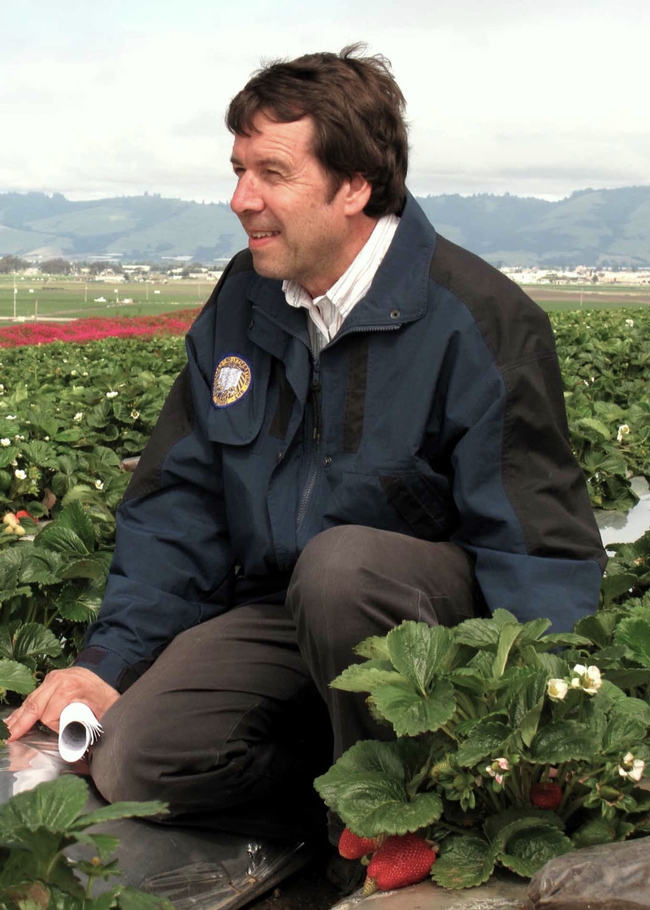- Author: Kathy Keatley Garvey
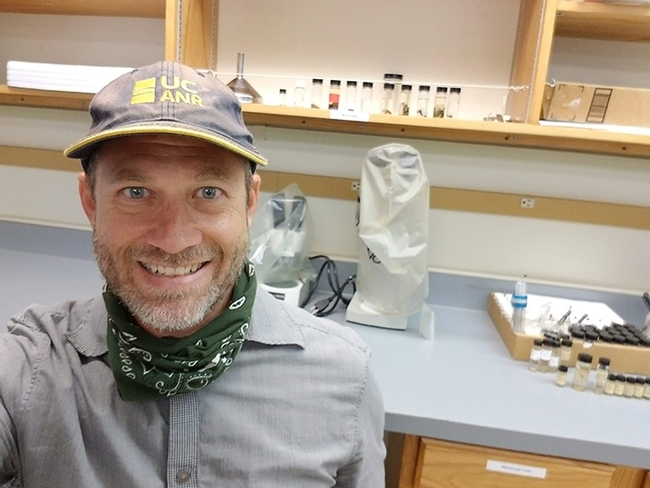
First, emeritus Cooperative Extension specialist Vernard Lewis of UC Berkeley, highly respected as "The Termite Man," drew widespread attention on Nov. 2 when he delivered the Founders' Memorial Lecture on "The Termite Lady," Margaret James Stickland Collins (1922-1966), at the Entomological Society of America's annual meeting, held in Denver.
Lewis covered the life and legacy of Collins, an African-American entomologist and civil rights advocate whose termite research spanned five decades. Lewis praised her "pioneering studies on the mechanism and evolution of termite desiccation resistance across various habitats provided foundational knowledge for generations of entomologists, field biologists, and ecologists."
Did termites fade into obscurity after Lewis' heralded ESA seminar?
No. Not a chance. "Love" saw to that.
The heavy winter rains in the Bay Area, followed by warm sunny days, resulted in the timely emergence of subterranean termites "looking for love," noted University of California Urban Integrated Pest Management (IPM) advisor and urban entomologist Andrew Sutherland, who serves the San Francisco Bay Area counties of Alameda, Contra Costa, San Francisco, San Mateo, and Santa Clara.
"Interestingly, this year's subterranean termite swarms generated way more pop media interest than usual," said Sutherland who holds a doctorate in entomology (2009) from UC Davis. "Perhaps it's because we had more people at home than in previous years (pre-COVID...also, 2019 and 2020 swarms occurred during Thanksgiving weekend, so folks may have been preoccupied or traveling)."
"Since they live underground, they have to have opportunities to meet and fall in love," Sutherland told journalist Leah Worthington of the Redwood City Pulse. "So it's kind of like a big singles bar in the air...The king and queen form what's called a nuptial pair. And that nuptial pair starts a colony, usually in a piece of wood that is partially buried in the soil."
Sutherland's program contributed to three news media pieces; a UC Agricultural and Environmental Sciences (UC ANR) blog; and a LinkedIn post:
- ABC 7 TV spot
- Redwood City Pulse story (also published in Palo Alto Online)
- San Francisco Gate story
- UC Agriculture and Natural Resources (UC ANR) blog post
- LinkedIn post
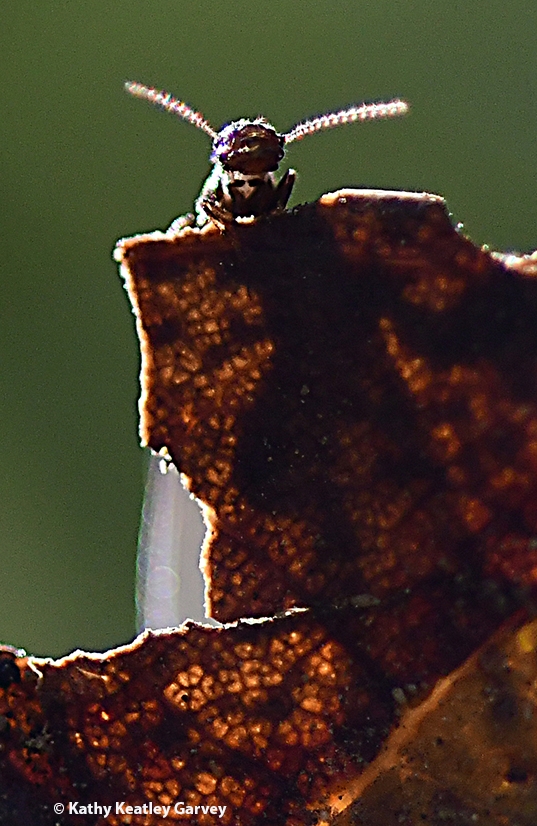
"Up here in the San Francisco Bay Area, we're continuing evaluations of bait station systems and investigations into the western subterranean termite species complex," Sutherland said.
In his UC ANR blog, published Oct. 21--in the midst of the fall subterranean termite swarm season--Sutherland explained the situation well:
"It's that time of year again: termite swarm season! Western subterranean termites, Reticulitermes hesperus (species complex), produce reproductive swarms during calm sunny periods immediately following the first autumn rains. This is especially pronounced in the San Francisco Bay Area and parts of the Sacramento Valley, where mature termite colonies across a broad region may swarm simultaneously en masse, filling the air with termites fluttering their gossamer wings and filling social media discussions with wonder, horror, confusion, and dread."
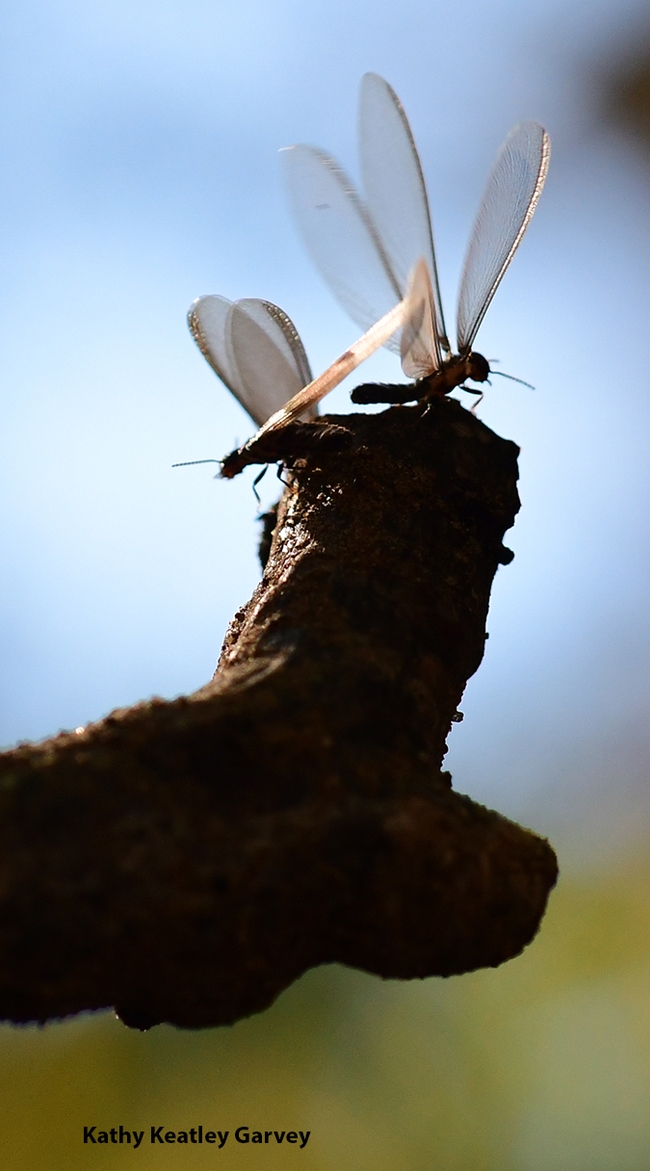
A Solano County homeowner witnessed the phenomenon on Oct. 27. She saw hundreds of them exiting the soil by her ailing black walnut tree on Buck Avenue, Vacaville. The insects literally carpeted the ground and sprawled out on fallen leaves. As the sun warmed their flight muscles, the winged termites took off--right into the beaks of swooping birds.
What should you do if you spot a swarm?
As Sutherland wrote in his blog: "If observing a swarm on your property, especially if near your home or other structures, you can hire a professional termite company for a detailed inspection. Make sure to photograph or otherwise note the swarm location so that the inspector can start there. Even if you don't see swarms on your property, regular (every three to five years) inspections will help detect infestations before they cause significant damage and prevent future infestations. There are several proven management strategies for termites; review UC IPM's Pest Notes: Subterranean Termites."
"For now, perhaps we can all appreciate the wonder of this natural spectacle," Sutherland wrote. "Winged termites are great sources of food for birds, lizards, other insects, and spiders. Termites also provide important ecosystem services, such as decomposition of wood and fallen leaves, contribution to soil structure formation, enhancement of water infiltration in soil, and facilitation of nutrient availability to plants. Furthermore, western subterranean termites are native to California and have been here long before we built wooden structures on top of their colonies. (Termite) love is in the air!
The UC IPM Pest Note relates that "Subterranean termites are common throughout California and can be found infesting fallen trees, stumps, or other dead wood in contact with the soil in the forest, landscape, or structural lumber in our houses...The most common subterranean termites, Reticulitermes, can be encountered in nearly all regions of the state, from the sand dunes of the coast to the upper elevations of the mountain ranges and even in some of the desert areas. The species of Reticulitermes are the most destructive termites found in California. They are small in size compared to dampwood and drywood termites, but mature colonies can contain hundreds of thousands of individuals."
Urban entomologist Thomas Chouvenc of the University of Florida wrote about controlling termites in his article, "Killing It in the Eggs: A Termite Bait Story," published Dec. 7 in ESA's Entomology Today. "Subterranean termites represent a legitimate concern for many homeowners in the United States because of their potential damage to wood structures," he began and went on to discuss chitin synthesis inhibitor (CSI) bait formulations.
CSI is something that termites looking for love want no part of.
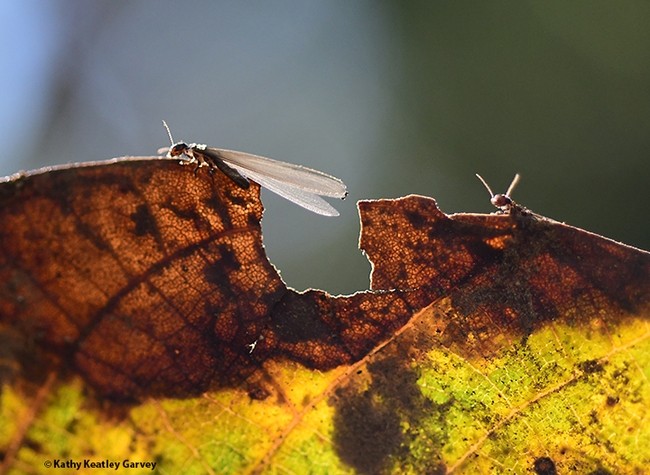
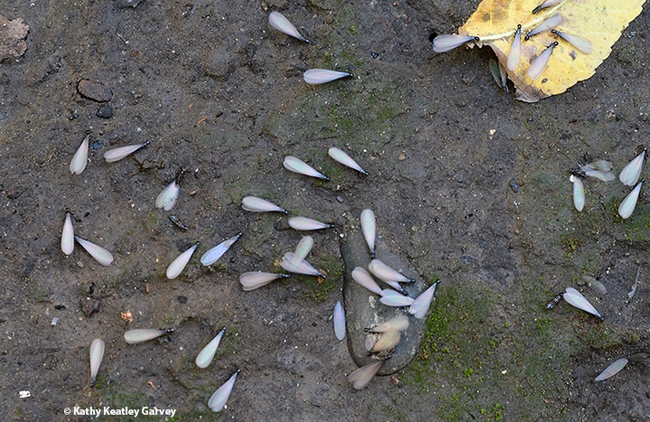
- Author: Kathy Keatley Garvey
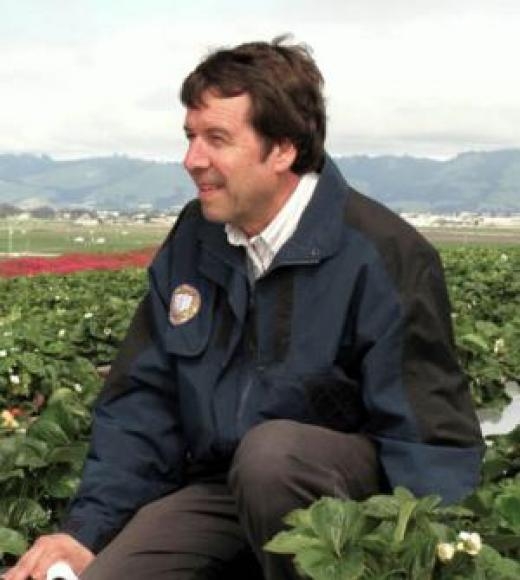
But he's an entomologist with an incredible reach that extends in practically all corners of the insect science world. He's like the equivalent of a griffinfly from the extinct genus Meganeuropsis, a huge insect with a wingspan of 27 inches.
Indeed, the reach of UC Davis distinguished Frank Zalom UC Davis distinguished professor, is quite comparable.
Zalom, a noted integrated pest management (IPM) specialist and a past president of the Entomological Society of America (ESA), is a newly elected Honorary Member of the ESA, an honor bestowed for his “long-term dedication and extraordinary contributions” to the 7000-member global organization. Honorary Member is the highest honor that can be afforded an ESA member.
Zalom, praised as “an entomological giant” and “the consummate ambassador to entomology,” joins five other entomologists as Honorary Members. They will be honored at the ESA's annual meeting, Entomology 2021, set Oct. 31-Nov. 3 in Denver.
“Honorary membership acknowledges those who have served ESA for at least 20 years through significant involvement in the affairs of the society that has reached an extraordinary level,” an ESA spokesperson said. “Candidates for this honor are selected by the ESA Governing Board and then voted on by the ESA membership.”
“Dr. Zalom is phenomenal for his sustained service of leadership, research, teaching and mentoring, and in my opinion, he is one of the world's most influential, accomplished and inspirational entomologists,” wrote nominator James R. Carey, a UC Davis distinguished professor of entomology and an ESA Fellow. ESA Honorary Member and ESA Fellow Philip Mulder, emeritus professor and former department chair at Oklahoma State University, noted: “Frank is and was the consummate ambassador to entomology throughout his entire career and around the globe on multiple occasions.”

A 47-year member of ESA, Zalom is an emeritus professor with the UC Davis Department of Entomology and Nematology, and currently a recall professor, continuing his work on IPM of tree, vine and fruiting vegetable crops through several major USDA and CDFA research grants he has received since retiring. Since his retirement, he has brought in more than $1 million in grants. Zalom is also working with Professor Rachael Goodhue, chair of the UC Davis Agricultural and Resource Economics Department on an ongoing pesticide policy research project involving "economic and pest management analyses of potential regulations in strawberry, tomato, and other fruiting crops" in collaboration with CDFA's Office of Pesticide Policy and Analysis.
Zalom directed the UC Statewide Integrated Pest Management Program (UC IPM) for 16 years (1986-2002). “Frank elevated it to 'the gold standard' of the world's IPM programs, emphasizing ecologically based pest management programs for agriculture, urban settings and natural resources,” Carey wrote.
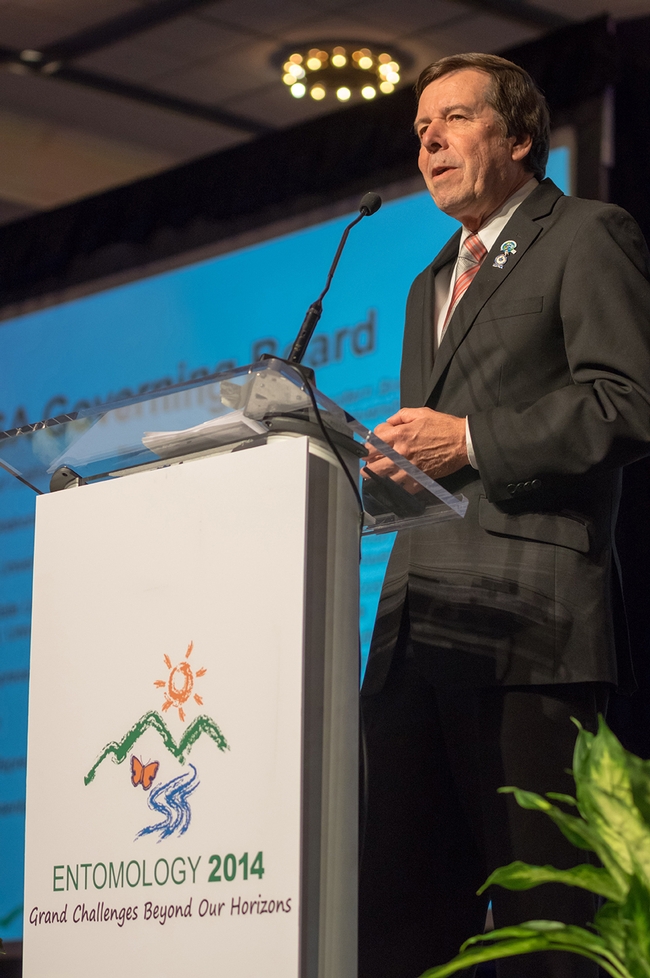
The UC Davis entomologist has authored nearly 400 journal publications or book chapters, and more than 400 other publications. He holds two U.S. patents.
Passionate about moving science policy forward, Zalom served as ESA's Science Policy Committee Chair in 2015. In 2018, he co-organized a two-day summit, Grand Challenges in Entomology in South America, hosted by the Entomological Society of Brazil. The summit focused on invasive species, public health, and sustainable agriculture, and included invited leadership from all entomology societies in Central and South America. Zalom also co-organized the North American and Pacific Rim Invasive Insect and Arthropod Species Challenge Summit, jointly hosted by the entomological societies of America, Canada and British Columbia in Vancouver, BC in 2019.
Highly honored by his peers, Zalom is a Fellow of four scientific organizations: ESA; the American Association for the Advancement of Science, California Academy of Sciences, and Royal Entomological Society. His numerous awards include the BY Morrison Memorial Medal from USDA-ARS and American Society for Horticultural Science (2017), ESA's Recognition Award (2002), Outstanding Achievement Award in Extension Entomology (1992), Excellence in IPM Award (2010), IPM Team Award (2008), and the Pacific Branch Woodworth Award (2011).
Among his UC Davis recognitions are the Consortium for Women in Research Outstanding Mentor Award (2013), James H. Meyer Award (2004), and Academic Senate Distinguished Scholarly Public Service Award (2017).
A native of Chicago, Frank moved to Arizona with his family at age 4. He received his bachelor's degree and master's degrees in zoology and ecology from Arizona State University, 1973 and 1974, respectively, and his doctorate in entomology from UC Davis in 1978. He joined the University of Minnesota faculty as assistant professor before returning to UC Davis in 1980.
“Throughout his career the depth of his knowledge in IPM was matched by the strength of his commitment to teaching students and postdocs, as well as by the power of his dedication to helping growers in all areas of agricultural entomology,” Carey wrote. “A former Fulbright Scholar, Frank is both a visionary and dedicated entomologist who has devoted his life's work to advancing entomology and ESA programs. His expertise is in great demand from colleagues, agriculturists, policy makers, students and more. He is the consummate entomologist, intricately skilled and highly accomplished.”
Zalom is the fifth UC Davis scientist to be selected ESA Honorary Member. W. Harry Lange (1912-2004) received the award in 1990; Donald MacLean (1928-2014), the 1984 ESA president, won the award in 1993; Bruce Eldridge in 1996, and John Edman in 2001.

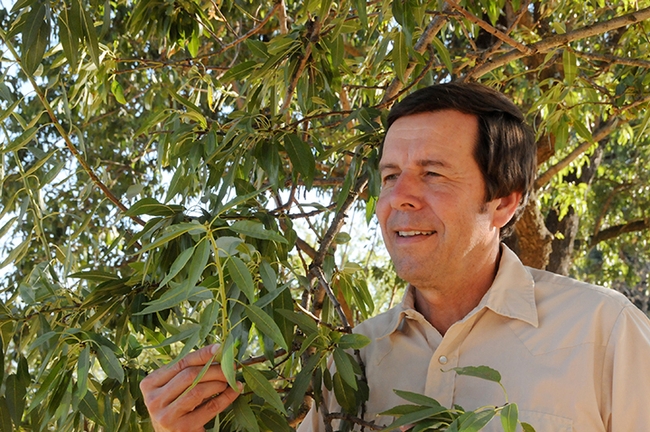
- Author: Kathy Keatley Garvey

Agricultural entomologist and Cooperative Extension specialist Ian Grettenberger, who joined the faculty of the UC Davis Department of Entomology and Entomology in January 2019, targets a variety of pests, including western spotted and striped cucumber, beetles, armyworms, bagrada bugs, alfalfa weevils, aphids, and thrips
Grettenberger, who fills the vacated position of Larry Godfrey (1956-2007), received his bachelor of science degree in biology, with an ecology, evolution and organismal emphasis (honors Program) in 2009 from Western Washington University, Bellingham, Wash., and his doctorate in entomology in 2015 from Pennsylvania State University, State College, Pa. He served as a postdoctoral researcher in the Godfrey lab and later, the Frank Zalom lab, before accepting his current appointment of assistant Cooperative Extension specialist.
Grettenberger's fields of expertise include field and vegetable crops; integrated pest management; applied insect ecology, and biological control of pests.
Among his current grants:
- Protection of rice from invertebrate pests
- Management of key cotton arthropod pests with insecticides and acaricides, a proactive approach to prepare for the invasion of the tomato leafminer (Tuta absoluta) into California
- Detection, biology and control of the exotic Swede midge (Contarinia nasturtii) for California cole crops
- Management of the western spotted and striped cucumber beetle in melon production
- Biological control of the bagrada bug
- Insecticide resistant alfalfa weevils in the western United States:Quantifying the scope of resistance and implementing a plan to manage the threat
- Insecticide resistance monitoring and evaluation of efficacy of current chemical tactics for managing aphids and thrips in lettuce
How did you get interested in entomology? Can you recall an occasion that sparked your interest?
I had biologist parents, and was drawn into entomology at a pretty young age. I spent plenty of time looking in flowers and turning over logs looking for insects. Once I started thinking about going to graduate school for entomology, I decided to focus on the intersection of agricultural entomology and insect ecology. I wanted to work on applied issues in entomology.
How would you describe yourself?
I like tackling problems, which has worked out well with my work in applied entomology and extension. I can be intensely focused and immensely distracted, which I would say has its pluses and minuses.
What do you like best about your work?
I love working in applied entomology and that I get to use research to better understand pests and work to develop IPM tools. The breadth of crops I cover is both a bit overwhelming but immensely exciting because of the diversity in pest issues, types of tactics that are applicable, and interesting ecological/biological questions among the various crop pests. I also get to work with great people, both within my lab and with all of the various collaborators/cooperators. I have met and worked with a lot of fantastic people this first year, and I also think my lab is off to a great start.
Where were you born and where did you spend your childhood?
I was born in Portland, Ore., but I primarily grew up in Olympia, Wash. As you might imagine, I grew up with lots of rain, but in a beautiful area.
What are your research plans/goals here at UC Davis? What drew you to UC Davis?
Thus far, I have been focused on projects in crops where there has historically seen solid research by UC Davis (such as rice and cotton) and have been developing new projects and collaborations. For better or worse, IPM is never static, so my research will be continually evolving to address pest management needs and has already been shifting this first year. Because I have an extension appointment, stakeholder needs have driven much of my work and this will continue to be a theme.
I was drawn to Davis by the many opportunities it would afford working in agricultural entomology. The department has a great reputation academically and the people in it are great as well. I also would have (and have had) the opportunity to connect with many other great researchers in the UC system, both campus- and county-based. There are many crops and pests to work on. We are quite literally surrounded by crops I work in, including alfalfa, rice, and tomatoes. I even found some alfalfa weevil on my run last weekend.
What do you like to do in your leisure time?
My primary hobby is running, ideally on trails and long distances. I can deal with the nearly zero elevation gain in our area, but I like to get out to where there are some hills. I also like to be outdoors in general and spending time with my family (wife/dog/cat; dog will go on adventure runs with us, cat only gets the backyard).
What would people be surprised to know about you?
I don't like all foods, but I will try basically anything just to see what it tastes like. I think some people are also surprised by the amount of food I can eat at one time.
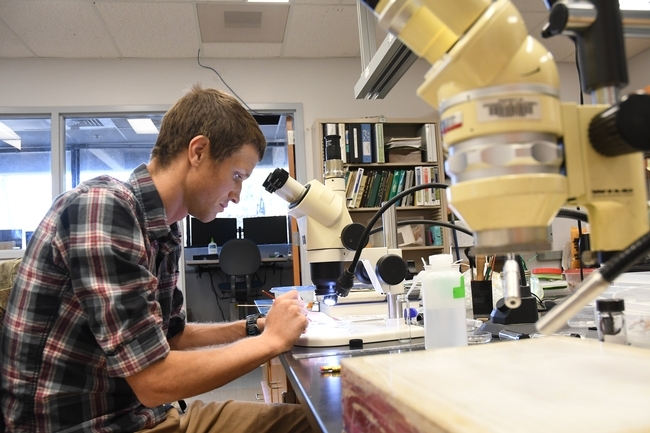

- Author: Kathy Keatley Garvey
Let's hear it for biocontrol.
You've seen lady beetles, aka ladybugs, preying on aphids.
But have you seen an assassin bug attack a spotted cucumber beetle?
No?
How about a crab spider munching on a stink bug?
All biocontrol, part of integrated pest management (IPM).
If you access the University of California Statewide Integrated Pest Management Program (UC IPM) website or more specifically, this page, you'll learn that "Integrated pest management, or IPM, is a process you can use to solve pest problems while minimizing risks to people and the environment. IPM can be used to manage all kinds of pests anywhere–in urban, agricultural, and wildland or natural areas."
Or, UC IPM's more in-depth definition:
"IPM is an ecosystem-based strategy that focuses on long-term prevention of pests or their damage through a combination of techniques such as biological control, habitat manipulation, modification of cultural practices, and use of resistant varieties. Pesticides are used only after monitoring indicates they are needed according to established guidelines, and treatments are made with the goal of removing only the target organism. Pest control materials are selected and applied in a manner that minimizes risks to human health, beneficial and nontarget organisms, and the environment."
Think of biocontrol as beneficial: "Biological control is the beneficial action of predators, parasites, pathogens, and competitors in controlling pests and their damage. Biological control provided by these living organisms (collectively called "natural enemies") is especially important for reducing the numbers of pest insects and mites, but biological control agents can also contribute to the control of weed, pathogen, nematode or vertebrate pests."--UC IPM
Yesterday we witnessed an incredible case of biocontrol in action.
At Bodega Bay's Doran Regional Park, Sonoma County, we spotted a great blue heron stepping stealthily through a thatch of ice plant in the Jetty campground. It was 6:30 in the morning. As campers slept in their recreational vehicles a few feet away, the great blue heron just kept stepping silently through the ice plant. One step. Another step. And another.
And then it happened. Its long sharp beak speared a rodent. Yes, they eat rodents. It crunched the body from head to toe, breaking the bones, and then swallowed it whole.
Not a pretty picture, but a simple case of biocontrol, compliments of a hungry heron.
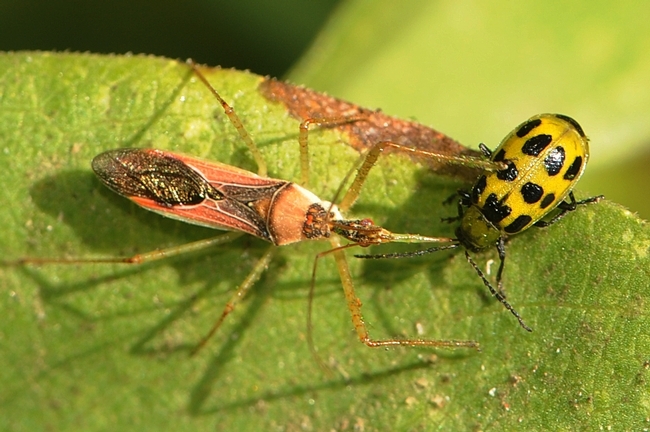
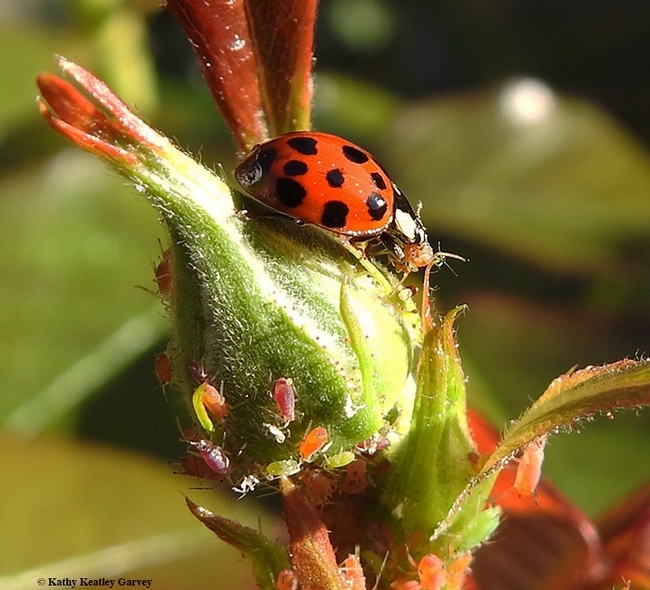
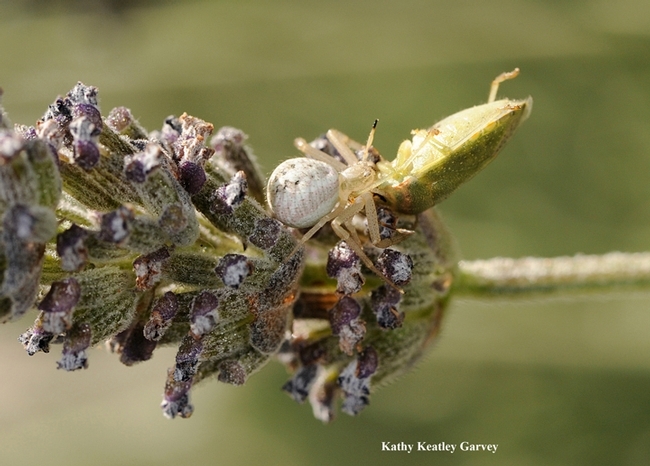
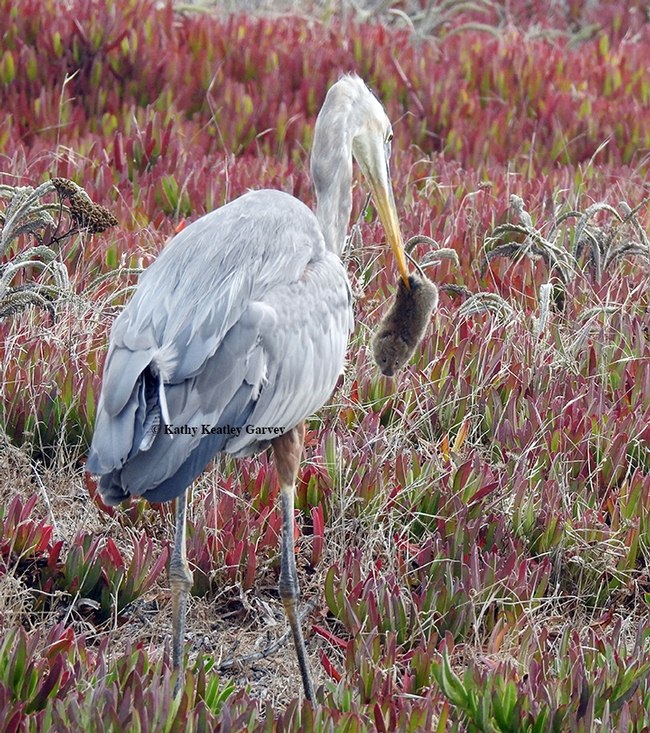
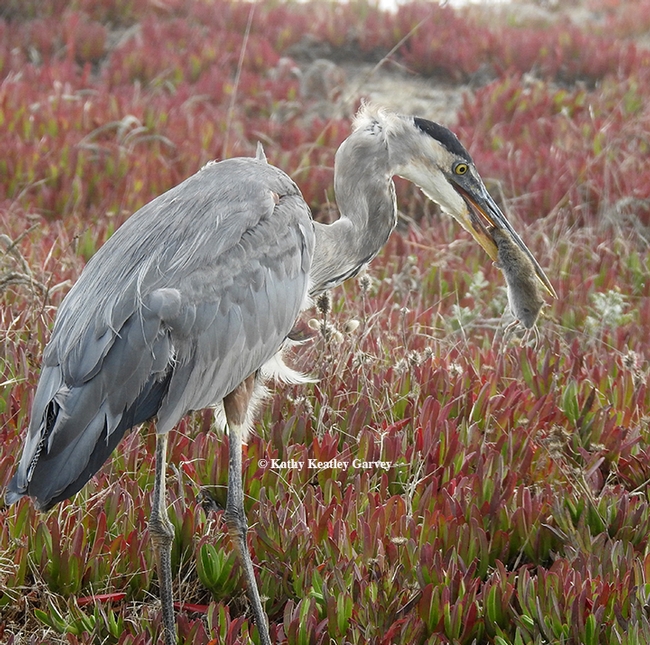
- Author: Kathy Keatley Garvey


They go together like superman (Clark Kent) and supervillian (Lex Luthor). Or like Coccinellidae (lady beetles) and Aphididae (aphids).
Fact is, IPM specialist Frank Zalom, a distinguished professor of entomology and Extension entomologist at the University of California, Davis, targets pests. He solves pest problems the IPM way--using effective, biologically based pest management approaches.
Over the last four decades, he has honed an incredible career. Absolutely incredible.
And now he's receiving a well-deserved lifetime achievement award at the Ninth International IPM Symposium March 19-22 in Baltimore.
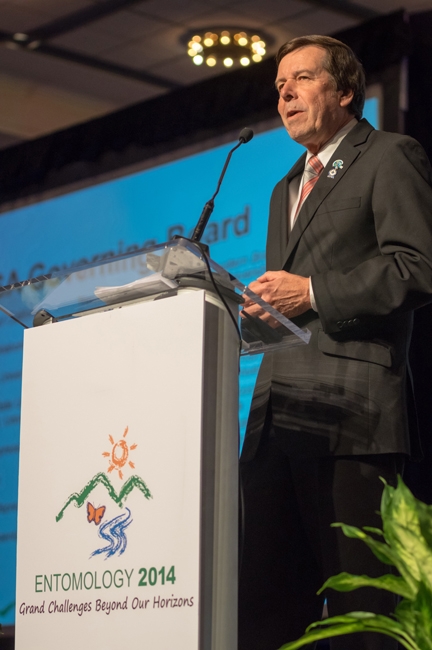
“Dr. Zalom continues to advance the science and implementation of IPM,” said Steve Nadler, professor and chair of the UC Davis Department of Entomology and Nematology. “His integrity, service and respect for all are legendary.”
At the Baltimore seminar, Zalom will deliver a presentation on “The ‘I' in IPM: Reflections on the International IPM Symposium and Evolution of the IPM Paradigm.” He will reflect on his 16 years co-chairing the Association of Public and Land-Grant Universities' National IPM Committee, the committee that launched the symposia. Zalom also played a role in organizing the first four IPM Symposia.
In addition, Zalom and fellow members of the UC European Grapevine Moth Team will receive an award of excellence for contributing to eradication of the pest in 2016--only six years after its discovery in California vineyards.
The only other lifetime achievement award recipient this year also has a UC connection: Peter Goodell, UC IPM advisor emeritus, affiliated with the Kearney Agricultural Research and Extension Center. And a longtime friend and colleague of Frank Zalom.
Zalom, who holds a doctorate in entomology from UC Davis, teaches arthropod pest management, targets pests using IPM methods, and develops major agricultural IPM programs for California's specialty crops.
Zalom is a past president of the 7000-member Entomological Society of America; co-founder of the International IPM symposia; and for 16 years, directed the University of California Statewide IPM Program, considered “the gold standard” of IPM programs.
Zalom's 16 years at the helm of the UC IPM program set the standard, nationally and globally, for subsequent IPM programs. He established a statewide, interdisciplinary IPM team of Cooperative Extension farm advisors, and oversaw development of the website's online degree-day tool, and the database of degree-day models that remains widely used by California's county-based extension staff and crop consultants.
“Advancing the science and implementation of IPM will reduce the impact of pests and pest control on agriculture and the environment,” Zalom said. “This is critical in California, where we grow more than a third of our nation's vegetables and two-thirds of our nation's fruits and nuts. California agriculture is a $42.6 billion industry that generates at least $100 billion in related economic industry.”
The Zalom laboratory has helped establish biologically based IPM programs for arthropod pests of California tree, vine, small fruit and vegetable crops valued at over $19 billion. The lab has addressed 17 invasive species introductions, among them southern green stink bug, silverleaf whitefly, glassy-winged sharpshooter, olive fly, invasive saltcedar, light brown apple moth, spotted wing drosophila, and most recently European grape vine moth, brown marmorated stink bug and bagrada bug. Specific programs have reduced insecticide use and pesticide runoff into surface waters, and resulted in more effective management of several key and invasive pests of specialty crops.
Zalom interacts broadly with research colleagues, extension educators, growers, consultants, environmental groups, and public agency personnel throughout the state, nation and world to advance the science and use of IPM. He has served on scores of national ad hoc committees of agencies and organizations that shaped IPM policy and directions. He was recently appointed to a new Council for Agricultural Science and Technology (CAST) task force that will produce a white paper on behalf of the organization on Integrated Pest Management. He previously served on the task force for the CAST Issue Paper, “Feasibility of Prescription Pesticide Use in the United States."
Zalom's professional goals are four-fold (1) to solve pest problems using effective, biologically based pest management approaches; (2) to provide IPM leadership at the regional, state, national and international levels, (3) to maintain a vigorous cutting edge research program in entomology, especially related to IPM and invasive species; and (4) to educate a new generation of IPM practitioners through effective undergraduate teaching and graduate student mentoring.
Zalom has pursued his goals through a combination of fundamental studies related to pest biology, physiology, and community ecology; problem-focused, hypothesis-driven management research; and community-oriented extension efforts. “I focus my research on exploiting weaknesses in the biology of a pest species and its niche in the agroecosystem or the broader landscape,” Zalom said.
Among his many accomplishments:
- Appointed the first Editorial Board chair of ESA's new Journal of Integrated Pest Management.
- Founding member of the steering committee for the USDA-NIFA Pest Management Information Platform for Extension (ipmPIPE), an effort intended to assess risk of disease and insect outbreaks.
- Co-principal investigator of the USDA grant for $3.49 million that originally funded the Western IPM Center, located at UC Davis
- Numerous leadership roles in the Entomological Society of America (ESA), including president in 2014, member of ESA's presidential line for four years and Governing Board member for four years. He also served as the president of the Entomological Foundation and first chair of ESA's new Science Policy Committee.
- Author of more than 350 peer-reviewed journal articles, book chapters, and books, and has served as major professor for 12 Ph.D. students and seven master's students.
- Recipient of multiple awards at UC Davis including one for his outstanding mentoring, of women graduate students and post-doctoral scholars.
- Co-chair of the International Entomology Leadership Summit in 2016 in Orlando,Fla.
Zalom is a fellow of the California Academy of Sciences, Entomological Society of America, American Association for the Advancement of Science, and Royal Entomological Society (London). Previous IPM awards include the Entomological Foundation's IPM Team Award and Excellence in IPM Award, and the Perry Adkisson Distinguished Speaker Award from Texas A&M University. He is the only entomologist to be awarded the BY Morrison Memorial Medal for horticultural research, presented by the Agricultural Research Service of the U.S. Department of Agriculture, and the American Society for Horticultural Science.
Zalom, who joined the UC Davis faculty in 1980, shortly after receiving his doctorate of entomology in 1978, earned both his bachelor's and master's degrees in zoology and ecology from Arizona State University, Tempe.
Now it's off to Baltimore to receive a well-deserved honor. Congratulations, Frank Zalom, champion of IPM!
